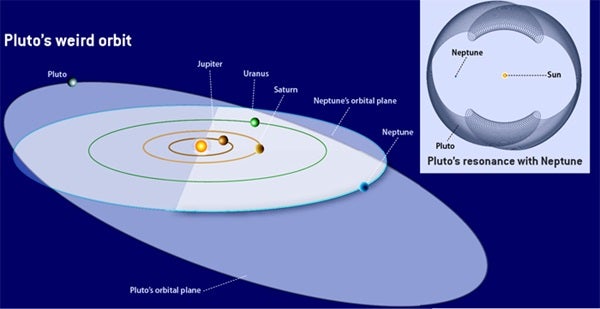Neptune’s orbit is essentially circular and in the same plane as most planets (the ecliptic plane), while Pluto’s orbit is elliptical and tilts 17º to the ecliptic. So, if Pluto and Neptune were placed on their orbits at the same distance from the Sun, we would find Pluto typically 5 or 6 times the Sun-Earth distance (5 or 6 astronomical units, or AU) above or below the ecliptic.
The closest distance between the two orbits is 2.4 AU. If we could reach out magically and move Pluto and Neptune to any point in their orbits, the closest they could ever get is 2.4 AU. However, this minimum distance can never occur.
Pluto and Neptune have resonant orbits. While Pluto makes two revolutions around the Sun, Neptune makes three; so astronomers say Neptune and Pluto are in a 3:2 resonance. This orbital relationship limits the minimum distance between the two planets. They never get closer than about 16 AU.
This resonance has kept Pluto from being ejected from the solar system by Neptune’s gravity during the past 4.5 billion years. Because Pluto never gets close to Neptune, Neptune’s gravity can never alter Pluto’s orbit.
Many objects in the outer solar system have resonant orbits with Neptune. About 70 Kuiper Belt objects (KBOs) also share the 3:2 resonance, and there are others in different resonances (such as 7:4, 2:1, 5:2). As with Pluto, these resonant orbits protect their inhabitants from being perturbed by Neptune gravitationally. — LARRY WASSERMAN, LOWELL OBSERVATORY, FLAGSTAFF, ARIZONA










